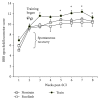Training-Induced Functional Gains following SCI
- PMID: 27403345
- PMCID: PMC4926009
- DOI: 10.1155/2016/4307694
Training-Induced Functional Gains following SCI
Abstract
We previously demonstrated that daily, hour-long training sessions significantly improved both locomotor (limb kinematics, gait, and hindlimb flexor-extensor bursting patterns) and nonlocomotor (bladder function and at-level mechanical allodynia) functions following a moderate contusive spinal cord injury. The amount of training needed to achieve this recovery is unknown. Furthermore, whether this recovery is induced primarily by neuronal activity below the lesion or other aspects related to general exercise is unclear. Therefore, the current study objectives were to (1) test the efficacy of 30 minutes of step training for recovery following a clinically relevant contusion injury in male Wistar rats and (2) test the efficacy of training without hindlimb engagement. The results indicate that as little as 30 minutes of step training six days per week enhances overground locomotion in male rats with contusive spinal cord injury but does not alter allodynia or bladder function. Thirty minutes of forelimb-only exercise did not alter locomotion, allodynia, or bladder function, and neither training protocol altered the amount of in-cage activity. Taken together, locomotor improvements were facilitated by hindlimb step training for 30 minutes, but longer durations of training are required to affect nonlocomotor systems.
Figures







Similar articles
-
Novel multi-system functional gains via task specific training in spinal cord injured male rats.J Neurotrauma. 2014 May 1;31(9):819-33. doi: 10.1089/neu.2013.3082. Epub 2014 Mar 25. J Neurotrauma. 2014. PMID: 24294909 Free PMC article.
-
Effects of exercise training on urinary tract function after spinal cord injury.Am J Physiol Renal Physiol. 2016 Jun 1;310(11):F1258-68. doi: 10.1152/ajprenal.00557.2015. Epub 2016 Mar 16. Am J Physiol Renal Physiol. 2016. PMID: 26984956 Free PMC article.
-
Task-specificity vs. ceiling effect: step-training in shallow water after spinal cord injury.Exp Neurol. 2010 Jul;224(1):178-87. doi: 10.1016/j.expneurol.2010.03.008. Epub 2010 Mar 17. Exp Neurol. 2010. PMID: 20302862 Free PMC article.
-
The "beneficial" effects of locomotor training after various types of spinal lesions in cats and rats.Prog Brain Res. 2015;218:173-98. doi: 10.1016/bs.pbr.2014.12.009. Epub 2015 Mar 29. Prog Brain Res. 2015. PMID: 25890137 Review.
-
Sensorimotor behaviour following incomplete cervical spinal cord injury in the rat.Behav Brain Res. 2005 Dec 7;165(2):147-59. doi: 10.1016/j.bbr.2005.07.025. Epub 2005 Sep 12. Behav Brain Res. 2005. PMID: 16157393 Review.
Cited by
-
Timeline of Changes in Biomarkers Associated with Spinal Cord Injury-Induced Polyuria.Neurotrauma Rep. 2021 Oct 27;2(1):462-475. doi: 10.1089/neur.2021.0046. eCollection 2021. Neurotrauma Rep. 2021. PMID: 34901942 Free PMC article.
-
Novel spatiotemporal analysis of gait changes in body weight supported treadmill trained rats following cervical spinal cord injury.J Neuroeng Rehabil. 2017 Sep 13;14(1):96. doi: 10.1186/s12984-017-0308-0. J Neuroeng Rehabil. 2017. PMID: 28903771 Free PMC article.
-
Bladder Responses to Thoracolumbar Epidural Stimulation in Female Urethane-Anesthetized Rats with Graded Contusion Spinal Cord Injuries.J Neurotrauma. 2025 Feb;42(3-4):229-241. doi: 10.1089/neu.2024.0209. Epub 2024 Sep 26. J Neurotrauma. 2025. PMID: 39264865
-
The Impact of Activity-Based Interventions on Neuropathic Pain in Experimental Spinal Cord Injury.Cells. 2022 Sep 30;11(19):3087. doi: 10.3390/cells11193087. Cells. 2022. PMID: 36231048 Free PMC article. Review.
-
Blocking of BDNF-TrkB signaling inhibits the promotion effect of neurological function recovery after treadmill training in rats with spinal cord injury.Spinal Cord. 2019 Jan;57(1):65-74. doi: 10.1038/s41393-018-0173-0. Epub 2018 Jul 12. Spinal Cord. 2019. PMID: 30002472
References
Publication types
MeSH terms
Grants and funding
LinkOut - more resources
Full Text Sources
Other Literature Sources
Medical

